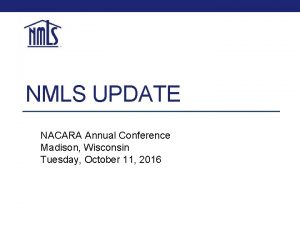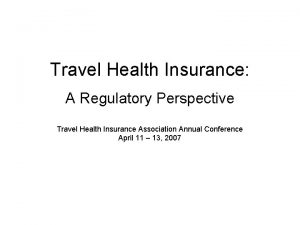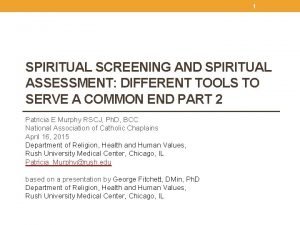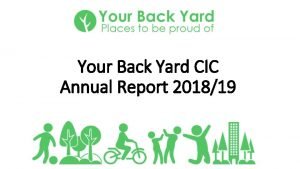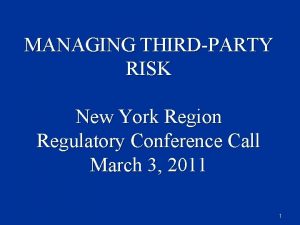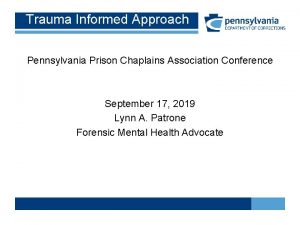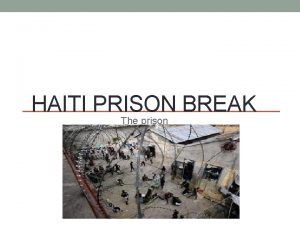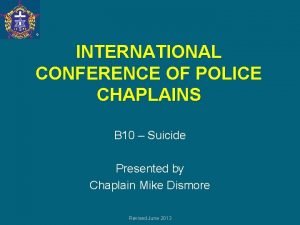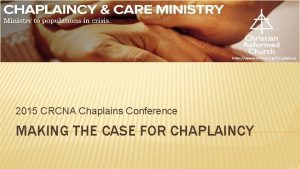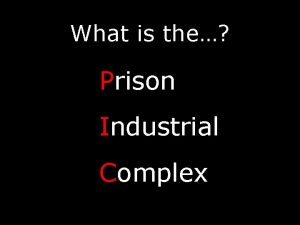Pennsylvania Prison Chaplains Association 2019 Annual Conference The


































- Slides: 34

Pennsylvania Prison Chaplains Association 2019 Annual Conference The Intersections of Chaplaincy and Mental Health: Suicide Prevention within an Incarcerated Setting Dr. Lucas D. Malishchak, DBA Director of the Psychology Office Pennsylvania Department of Corrections 1

Suicide in Jails and Prisons Jails 50 per 100, 000 Prisons 20 per 100, 000 Community 12 per 100, 000 5 th leading cause of death in prisons, after: (1) Heart disease, (2) Cancer, (3) Liver disease, (4) AIDS 2

PA DOC Suicides 3

Suicides in Correctional Settings What is it about the process of incarceration that may help explain why suicide rates are much higher amongst those incarcerated than compared to those in the community? 4

Attitudes about Suicide • Examples of negative attitudes? • Potential impact of negative staff attitudes about suicide? 5

Attitudes about Suicide Administration and Front Line Staff Attitudes about Suicide Our Expectation: ALL SUICIDES CAN BE PREVENTED “ NEGATIVE STAFF ATTITUDES IMPEDE SUICIDE PREVENTION EFFORTS” 6

Attitudes about Suicide • How do we implement the “right attitude” about suicides? 1. ) Take all threats seriously. 2. ) Those incarcerated are vulnerable. 3. ) Treat those incarcerated fairly and humanely. 4. ) Understand the seriousness of your role and responsibilities. 5. ) Be professional, at all times. 6. ) View suicide as EVERYONE’S responsibility. 7. ) Believe that all suicides can be prevented. 7

Communication and Collaboration To help eliminate suicides, there are three main stages of communicating concerning information pertaining to increased risk of suicide amongst incarcerated individuals: 1. ) Communication between transporting officer and correctional staff 2. ) Communication among all facility staff 3. ) Communication between facility staff and the at risk individual 8

Communication and Collaboration Communication between staff and the potentially suicidal individual REQUIRES a Private and Confidential Setting 9

“False Deniers” • Communication between staff and the potentially suicidal individual can be difficult. One example of how this process can be difficult is seen with false deniers. *SCENARIO* 10

“False Deniers” Upon finishing your service on Sunday morning, inmate Roberts approaches you in the vestibule of the Chapel. You ask Roberts if everything is ok and Roberts responded that he found out late last week that his grandmother passed away. In speaking to Roberts, you notice that he is somewhat sad, but indicates that his grandmother was almost 80 years old, so her passing was expected. As the conversation continues, you realize that you haven’t seen Mr. Roberts at service in the past several weeks, which is unusual for him as he is quite committed to his faith. Also, given your collaboration with other disciplines in the prison and your familiarity with Mr. Roberts’ life, you realize that he also hasn’t been to work in the Employee Dining Hall for the past few days. Upon recalling these factors, you ask to speak to Mr. Roberts in the privacy of your office. During the conversation in your office, Mr. Roberts indicates that he is expected to be paroled in the next few months, but was uncertain about his living situation in the community because of his grandmother’s passing. As the conversation progresses, you ask Mr. Roberts if he is having any thoughts about hurting or killing himself. Mr. Roberts states that, really, he is fine and he would never hurt himself because he has older kids that live in the Carolinas. 11

“False Deniers” • What do you do? • Refer to Psychology staff for an assessment. It appears quite possible that inmate Roberts is a “false denier” and may actually be having suicidal thoughts or plans despite stating the contrary to the Chaplain. • The take home message: there is more to risk assessment than simply relying on the individual’s input. 12

How do CHAPLAINS Assess for Suicide Risk? 13

Chronic Risk Factors (historic and demographic) that increase Suicide Risk Chronic Risk Factors (historic and demographic) include but not limited to: Family History of Suicide History of poor impulse control History of emotional, physical, or sexual abuse Perception of loss of social support History of major depressive disorder First prison term History of psychotic disorder Long or Life sentence Chronic pain problem Sex Offender Chronic medical illness Caucasian/White Ethnicity History of substance abuse Older than 35 years of age History of violence (including index offense) Male History of Suicide Attempts 14

Acute Risk Factors (Within 3 Months) that increase Suicide Risk Acute Risk Factors (Within 3 Months) include but not limited to: Suicidal Ideation (including passive ideation) Recent serious suicide attempt Current/recent depressive episode Current/recent psychotic symptoms Current/recent anxiety or panic symptoms current/recent substance abuse/intoxication Hopelessness/helplessness Increasing interpersonal isolation Current/recent violent behavior Recent bad news, loss, or anniversary date Recent trauma (including sexual trauma) Early in Prison term Recent change in housing (e. g. , RHU) Safety Concerns (e. g. , gang dropout) Agitated or angry Disturbance of mood/lability Recent negative staff interactions Evidence of medication hoarding Recent misconduct Recent serious medical diagnosis 15

Protective Factors Include but not limited to: Family Support (e. g. , visiting, correspondence) Active and motivated in psych treatment Religious/spiritual/cultural beliefs Sense of optimism; self efficacy Interpersonal social support Job or School Assignment Future orientation/plans for future Insight into problems Exercises regularly Spousal support Children at home Positive coping skills and conflict resolution skills 16

Safety Plan • A Safety Plan is a collaborative strategy developed by the individual and Psychology Staff member to identify those signs or symptoms that the individual may be decompensating and those specific steps the individual can take to be safe. • Safety plans are a critical piece of Suicide Risk Assessments that are completed by mental health professionals. • Main components of a Safety Plan: a. identification of warning signs and symptoms of decompensation b. coping skills that can be utilized to ensure personal safety c. interventions that will be provided from correctional staff to ensure safety 17

Review of past 12 years of DOC Suicides = 111 • • • • History of Psych Treatment: 79 or 71% Time between last MH contact and suicide: 79 occurred in less than 30 days or 71% Object used for Suicide: Bedsheet – 78 or 70% Inmate on MH Caseload: 75 or 68% Agitation at time of suicide: 18 or 16% History of substance abuse: 71 or 64% SIB prior to Suicide: 17 or 15% Inmate on Psychotropics: 61 or 55% Recent conflict with other inmate: 13 or 12% History of SSA or SIB: 55 or 50% Restricted Housing Unit: 42 or 38% Hopelessness at time of suicide: 13 or 12% History of Trauma or abuse: 36 or 32% History of Family suicide: 9 or 8% Psych Turmoil: 32 or 29% Recent decline in health: 6 or 5% Other Stressors: 30 or 27% Restricted Housing Unit: 27 Alienation: 8 or 7% Recent change in Psych meds: 26 or 23% Psychotic symptoms: 6 or 5% Depressive Symptoms: 25 or 23% Suicide plan identified: 5 or 5% Recently received bad news: 19 or 17% Sudden Change in MSE: 4 or 4% 18

PA DOC Suicides since 2008 19

PA DOC Suicides and Being Alone 20

Emergent Mental Health Referral Procedures • The situation represents an EMERGENCY. It MUST be handled right here, right now. • Making statements about being hopeless, lonely, depressed • Showing direct suicide warning signs Steps • Phone/Radio Call – inform about the situation • Follow direction from the Shift Commander/Unit Manage/ Chief Psychologist or Designee or ? 21

Non-Emergent Mental Health Referral Procedures • The situation does NOT represent an EMERGENCY. • Showing indirect suicide warning signs. Steps • DC-97 – Mental Health Referral Form • Submit to the Psychology department at the SCI 22

Non-Emergent Mental Health Referral-DC-97 23

Non-Emergent Mental Health Referral-DC-97 24

Non-Emergent Mental Health Referral-DC-97 25

Emergent versus Non-Emergent Referral Scenarios • Each case requires a referral. Determine which type of referral is indicated for each case and explain WHY you believe that type of referral is appropriate. • Case #1: Mr. Burns • Case #2: Ms. Hayes 26

Emergent versus Non-Emergent Referral Scenarios While doing chaplain rounds, you approach cell 1028 and observe inmate Burns alone in his cell. Mr. Burns’ cellmate is at work. Burns asks you if you have a minute to listen to a concern of his. Burns explains that he hasn’t had a chance to speak to the Chaplain in the past few days because he was out at court and was in the county jail for a week. Mr. Burns indicated that he typically sees his assigned Psychologist at least once per month. Burns indicated that while he was out to court, he received an additional 3 -6 years for a robbery. He indicated that he expected more time, but was somewhat disappointed that he would be missing his son’s graduation from college next year. Mr. Burns appeared withdrawn and particularly unhappy with the situation and noted that he would be appealing the new conviction. You recognize Mr. Burns from his regular attendance at your service. You have a fairly good relationship with Mr. Burns, as he frequently is open to discussing his spirituality with you. What type of Referral to Psychology do you believe is indicated? Emergent or Non. Emergent and Why? 27

Emergent versus Non-Emergent Referral Scenarios Correct Answer: NON-EMERGENT. Mr. Burns’ issues do not require immediate attention. Although they appear legitimate, they do not present an EMERGENCY that must be addressed immediately. Mr. Burns has indicated that he is experiencing some mild symptoms of depression, but also indicated that he is regularly (i. e. , at least once per month) seen by Psychology staff. However, you are aware that receiving additional time on top of one’s sentence is indeed “bad news” and can be particularly stressful for an individual that was anticipating going home within the next year. You identified that Mr. Burns did endorse at least some protective factors, including that he was looking towards the future (i. e. , he would be appealing his case). Informing Mr. Burns that you will submit a NONEMERGENT mental health referral to Psychology, via DC-97, will ensure that Psychology staff will see Mr. Burns within 1 week or five working days to address his concerns. 28

Emergent versus Non-Emergent Referral Scenarios • On Friday, you entered the Restricted Housing Unit to conduct Chaplain rounds. Upon approaching cell 1024, you see Ms. Hayes standing at her cell door. Ms. Hayes asks to speak to you briefly at the cell door. During her conversation, she reveals that she has lost hope of getting paroled because of the misconduct she received last week for “refusing to obey an order”. She indicates that she feels helpless and has been unusually reluctant to go to chow. Since you’ve worked in this prison for the past few years, you’ve never noticed Ms. Hayes to act this way, especially when she has attended your service. You ask Ms. Hayes whether or not she is contemplating suicide. Ms. Hayes states that she would never kill herself because she “loves life and herself. ” You ask Ms. Hayes if she is thinking about a plan of how to kill herself. Ms. Hayes reiterates that she would never kill herself but simply wanted to know when her cellmate would be returning from ATA (authorized temporary absence). Additionally, during your conversation with Ms. Hayes, you observe that she appears somewhat tearful though she seems to be holding back from completely crying. You know Ms. Hayes to have a strong conviction to her faith, and is extremely resilient in having dealt with many life and spiritual stressors during her incarceration. Ms. Hayes’ history is well known to you and other Chaplains in the prison, in that she has attempted suicide in the past following other stressful life events. These other self-injuries resulted in Psychiatric Observation and Mental Health Unit placements. 29

Emergent versus Non-Emergent Referral Scenarios • Correct Answer: EMERGENT referral to PSYCHOLOGY. • Although Ms. Hayes has indicated that she is not thinking about suicide or how she might kill herself, she has indeed reported hopelessness associated with her recent life changes. Additionally, given your tenure as a Chaplain in the prison, you know that Ms. Hayes has been seeking parole for some time now and that this represented a significant loss and stressor to her. Furthermore, Ms. Hayes has reported several other significant changes in her eating patterns, as well as other feelings of hopelessness and observations of tearfulness and an unusual inquiry about when her cellmate would return from ATA (which possibly suggests Ms. Hayes’ desire to identify an opportunity to self-harm). In weighing whether or not to make an EMERGENT or NON-EMERGENT referral to Psychology staff, you decide that you are not comfortable with Ms. Hayes having to wait until potentially Monday morning to see a Psychology staff member, as you are also aware that she has a history of serious self-injury which resulted in POC and MHU placements. Taking all factors into full consideration, Ms. Hayes’ situation does appear to present an emergency that should be assessed immediately by Psychology staff. As a result, you inform Ms. Hayes of your desire to have her assessed by Psychology staff immediately. She indicates that she is thankful of this opportunity and would welcome a chance to speak to Psychology in a private and confidential setting. As a result, you remain at Ms. Hayes’ cell and notify the rounding block officer immediately of the situation. Next, the correctional officer notifies Dr. Dan, the assigned block Psychologist, of the situation. Dr. Dan indicated that he is on his way down to cell 1024 to see Ms. Hayes. You remain with Ms. Hayes until Dr. Dan arrives. 30

Mental Health Referral Procedure REMINDERS Depending on how “emergent” the situation is will dictate the staff member’s action. A DC-97 is NOT appropriate for every situation. Remember, for those instances deemed to be EMERGENCIES, an EMERGENT response is required. A DC 97 is NOT appropriate for an emergency. The Psychiatric provider initiates suicide precautions as per program policy. 31

Mental Health Referral Procedure REMINDERS • For emergent referrals, do not leave the individual alone until a mental health professional is able to see the patient. Once Psychology is notified of an emergent referral, Psychology staff are to IMMEDIATELY see the person. • A non-emergent referral may be made to psychology for further evaluation and treatment. If Psychology determines that it is necessary, Psychology staff will refer the person to Psychiatry. 32

Concluding Remarks • Attitude, communication, and collaboration mean everything. • False Deniers • Consider Risks. Consider Protective Factors. Ask about their Safety Plan • ALONE • Emergent vs. Non-Emergent Referrals 33

Questions Dr. Lucas D. Malishchak, DBA Director of the Psychology Office Pennsylvania Department of Corrections LMalishcha@pa. gov 717 -728 -2093 34
 Nmls conference
Nmls conference Travel health insurance association annual conference
Travel health insurance association annual conference 7x7 spiritual assessment tool
7x7 spiritual assessment tool Pennsylvania forest products association
Pennsylvania forest products association Pennsylvania association of school business officials
Pennsylvania association of school business officials Cfa society pittsburgh
Cfa society pittsburgh Cic annual report 2019
Cic annual report 2019 Fuze conference 2018
Fuze conference 2018 Stfm abstract submission
Stfm abstract submission Problemitize
Problemitize Annual conference on pbfeam
Annual conference on pbfeam Stfm conference
Stfm conference Hepi annual conference
Hepi annual conference Njdv
Njdv Gcyf 2011 annual conference
Gcyf 2011 annual conference Https //bit.ly2v
Https //bit.ly2v Gie annual conference
Gie annual conference Iowa league of cities annual conference
Iowa league of cities annual conference Od network
Od network American psychiatric association annual meeting 2020
American psychiatric association annual meeting 2020 The microcap conference 2019
The microcap conference 2019 Third party risk management conference 2019 new york
Third party risk management conference 2019 new york Mil std 889
Mil std 889 Cdha contact
Cdha contact Nordic navigation
Nordic navigation Wasfaa conference 2019
Wasfaa conference 2019 Executive assistant conference 2019
Executive assistant conference 2019 Png investment conference 2019
Png investment conference 2019 Appa eo conference 2019
Appa eo conference 2019 Fasfaa conference
Fasfaa conference Vasfaa conference 2019
Vasfaa conference 2019 2019 dod allied nations technical corrosion conference
2019 dod allied nations technical corrosion conference Deutsche bank high yield conference 2019
Deutsche bank high yield conference 2019 Esop conference 2019 las vegas
Esop conference 2019 las vegas Ppl members
Ppl members
